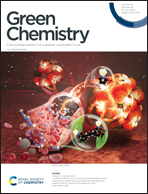Controlling the toxicity of biomass-derived difunctional molecules as potential pharmaceutical ingredients for specific activity toward microorganisms and mammalian cells†
Abstract
A biomass-derived difuran compound, denoted as HAH (HMF–acetone–HMF), synthesized by aldol-condensation of 5-hydroxyfurfural (HMF) and acetone, can be partially hydrogenated to provide an electron-rich difuran compound (PHAH) for Diels–Alder reactions with maleimide derivatives. The nitrogen (N) site in the maleimide can be substituted by imidation with amine-containing compounds to control the hydrophobicity of the maleimide moiety in adducts of furans and maleimide by Diels–Alder reaction, denoted as norcantharimides (Diels–Alder adducts). The structural effects on the toxicity of various biomass-derived small molecules synthesized in this manner to regulate biological processes, defined as low molecular weight (≤1000 g mol−1) organic compounds, were investigated against diverse microbial and mammalian cell types. The biological toxicity increased when hydrophobic N-substitutions and C![[double bond, length as m-dash]](https://www.rsc.org/images/entities/char_e001.gif) C bonds were introduced into the molecular structure. Among the synthesized norcantharamide derivatives, some compounds demonstrated pH-dependent toxicities against specific cell types. Reaction kinetics analyses of the norcantharimides in biological conditions suggest that this pH-dependent toxicity of norcantharimides could arise from retro Diels–Alder reactions in the presence of a Brønsted acid that catalyzes the release of an N-substituted maleimide, which has higher toxicity against fungal cells than the toxicity of the Diels–Alder adduct. These synthetic approaches can be used to design biologically-active small molecules that exhibit selective toxicity against various cell types (e.g., fungal, cancer cells) and provide a sustainable platform for production of prodrugs that could actively or passively affect the viability of infectious cells.
C bonds were introduced into the molecular structure. Among the synthesized norcantharamide derivatives, some compounds demonstrated pH-dependent toxicities against specific cell types. Reaction kinetics analyses of the norcantharimides in biological conditions suggest that this pH-dependent toxicity of norcantharimides could arise from retro Diels–Alder reactions in the presence of a Brønsted acid that catalyzes the release of an N-substituted maleimide, which has higher toxicity against fungal cells than the toxicity of the Diels–Alder adduct. These synthetic approaches can be used to design biologically-active small molecules that exhibit selective toxicity against various cell types (e.g., fungal, cancer cells) and provide a sustainable platform for production of prodrugs that could actively or passively affect the viability of infectious cells.

- This article is part of the themed collection: 2023 Green Chemistry Hot Articles


 Please wait while we load your content...
Please wait while we load your content...
